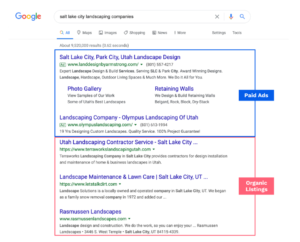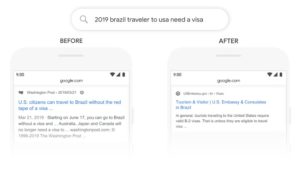When users type a query in a search engine, they are presented with results that include paid ads and organic search results. Organic traffic refers to visitors that come to a website from a search engine that was earned naturally, not paid for via advertising. And Search Engine Optimization (SEO) is the work that goes into ranking websites at the top of these organic search results.

SEO is all about online visibility. If your client’s business isn’t in the organic search results in the top ten organic positions on Google, they don’t exist to over 90% of searchers.
Ranking in the top ten positions of Google is an essential metric we monitor for an SEO campaign’s success. While many clients see an increase in impressions as they rank higher in Google’s SERPs, increased traffic is not guaranteed as part of an SEO campaign and we’ll explain why.
The Truth About Traffic
Website traffic comes from a variety of sources — by going straight to a website without using a search engine (direct), through linking referrals, paid ads, or social media. However, organic search is king and is responsible for 53% of all traffic coming to a website on average. While organic search traditionally delivers far more traffic to websites than any other channel, tracking organic traffic continues to be difficult.
There are 4 core intents when it comes to organic search. Each of these intents tie into different search layouts and results. This helps the searcher accomplish their goal (or intent) as quickly and accurately as possible.
Informational
-
- “Covid-19”
- “What is organic search traffic”
- “How to improve seo”
Transactional
-
- “Emergency plumber near me”
- “Buy replacement window screen”
- “Nintendo switch for sale”
Research
-
- “Best dentist near me”
- “Extra thick yoga mats”
- “Cheapest chromebook”
Navigational
-
- “Tsunami sushi Salt Lake City”
- “Boostability”
- “Netflix login page”
Each intent has different features that become part of the search result to make the result more useful and accomplish the intent better/faster. For example, navigational and transactional searches will likely yield map results with direct click-to-call and directions—while informational search results have a featured snippet or direct answer. Often referred to as “zero-click” traffic, these results are the main culprit in lost traffic. It is great for the user but requires no further action which means often there is no click or conversion. Other results, like research, typically yield expanded search features like Google tools (job listings widget, direct booking, etc.), related images, carousel results, and recommended videos.
Each of these additional search results/features detract from a website’s overall clicks and traffic, which is why we often see a rise in impressions (the amount of times content is displayed) rather than direct visits (clicks/traffic leading to a website).
Tracking Organic Traffic
How and where your client gets their organic traffic data can affect what they see and how accurate it is. The most common tools used for website analytics are Google Analytics, Google Search Console, Omniture (Adobe Analytics), and SEMRush. Each of these tools collect and measure data in different ways.
It is the slight differences in how traffic data is collected that cause discrepancies from one tool to another, affecting data accuracy between +4% to -11% of visits received. Even something as simple as a visitor’s default internet browser can affect reported traffic by up to 26%. Because no single tool can provide all the data needed to track a visitor on your client’s website, it’s important to pull data from multiple sources and piece it together to form a more comprehensive data picture.
Currently, the best source for keyword data is Google Ads (previously known as Google Adwords) Keyword Planner. However, this platform no longer provides average search volumes, rather they provide average search volume ranges. That means we don’t truly know what kind of search volume a keyword has since it falls within the fairly large ranges provided and depends on a variety of factors.

Missing data, miscategorized traffic, and spam also continue to be consistent and ever-changing issues with organic traffic. These issues have a larger impact on websites with smaller amounts of traffic. (Generally those with less than 5,000 visitors a month.) While these particular concerns can impact any website, it’s often less catastrophic to sites with higher traffic data.
Missing traffic can also come from ad-blockers, empty referrer data, timed-out sessions, missing cookies, or even disabled technology like javascript. All of these things lead to gaps in Google Analytics data.
Given today’s analytics toolset and functionality, there is no reliable way to tie keyword rank to organic traffic. Most clients can make a general case about improved traffic gains from improving keyword rankings, but tying this directly to a singular keyword or keyword phrase is simply not possible at this time.
Google Updates and Traffic
“My keywords are ranking on page 1 but my traffic went down,” is a common concern in our industry.
Traffic has a number of elements that no one can control, including seasonality, industry trends, bots, and Google algorithm updates. When Google implemented BERT in October of 2019, many business owners saw a drop in low-intent traffic. BERT better understands context and nuance in search queries. This update helped computers understand language more like humans do and helped match a searcher’s intent with more relevant results.
For example, let’s say someone from Brazil wants to know if they need a visa to visit the USA. According to Google, “The word “to” and its relationship to the other words in the query are particularly important to understanding the meaning. It’s about a Brazilian citizen traveling to the U.S., not the other way around. Previously, our algorithms wouldn’t understand the importance of this connection, and we returned results about U.S. citizens traveling to Brazil. With BERT, Search grasps this nuance and knows that the very common word “to” actually matters a lot here, and we can provide a much more relevant result for this query.”

When business owners saw their traffic dip after BERT’s implementation, it was largely traffic that was NOT relevant to their business to begin with.
While it’s important to always keep an eye on organic traffic, it is not a metric that should be viewed in isolation. If traffic is viewed correctly in year over year data, accounting for as many controllable variables as possible (correct installation, spam/bot/internal filtering, goal/conversion tracking, etc.), then it is a metric that can be viewed and used accurately to help support the benefits of increased organic rankings and organic leads/conversions. Otherwise it is best to keep it as a tracked side metric, but not touted as a guarantee.
How SEO Can Help
We can’t guarantee more traffic, but we can get your client to show up in the top ten listings on Google where they have the opportunity to be found by a more qualified group of searchers looking for their services/products.
Traffic Quality is More Important than Traffic Quantity
Forrester Group found the conversion rate of an optimized page is 200% higher.
At Boostability, we optimize your client’s website with the intent to buy in mind. We interpret “searcher intent”—the action searchers intend to take—for each keyword. This helps us identify people who are more likely to come to your client’s site ready to make a purchase. Rather than targeting users simply looking for information.
Bounce Rate
Bounce rate is defined as the percentage of visitors that leave a webpage without taking an action, such as clicking on a link, filling out a form, or making a purchase. Quality content and a user-friendly website (thanks, SEO!) can improve the browsing experience. It makes people want to stay on your client’s website longer. The longer people stay on a website, the more likely they are to make a purchase.
Traffic Conversion
Traffic alone is a vehicle. Better rankings lead to traffic. Traffic can lead to calls/visits. However, at the end of the day, you can’t beat a good customer experience and strong website content is what ultimately converts traffic into customers. It is imperative for your clients to have a website that is fully optimized for SEO, clear, and easy to navigate. Traffic doesn’t mean much if people don’t take action on what they see. If visitors aren’t converting, have your client review their business’ ability to close leads and ask the following questions:
- How are they encouraging people to come to their business?
- Are their phone numbers and call to actions prevalent?
- Who is ranking around them?
- Is their competition offering special discounts or sales?
- Is there anything that stands out as to why their competition is getting more leads?
To get your clients seen, they should be ranking in the top ten results of Google’s SERP. By improving the quality of the traffic visiting your client’s sites, the likelihood of traffic-to-lead conversion rates will increase. A well-optimized website, courtesy of SEO, that brings in both traffic and encourages people to take action will lead to higher success for your client’s business.
Learn more about our white label SEO program and see what approach we take to optimizing websites for our partners. Or if you have questions and want to speak with someone directly, get connected with a Partner Success Team member and find out if our white label SEO partnership is the right fit for you!


